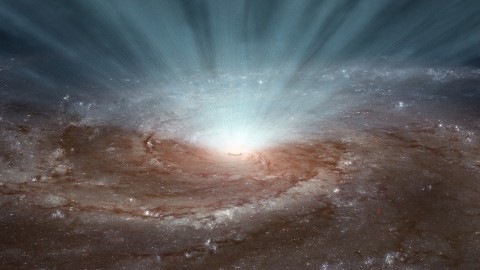Most Gigantic Black Hole Ever Found is 12 Billion Times Larger Than Sun
| Ana Verayo | | Feb 26, 2015 06:22 AM EST |
(Photo : NASA/JPL-Caltech) Supermassive black holes at the cores of galaxies blast radiation and ultra-fast winds outward, as illustrated in this artist’s conception.
Scientists said a colossal black hole 12 billion times bigger than the Sun apparently exists inside a glowing quasar almost as ancient as the Universe.
This new discovery challenges long held theories about how black holes and their host galaxies develop and devour each other over the eons.
Like Us on Facebook
Black holes are usually found inside super distant galactic bodies, namely quasars, and are so dense light can't even escape its powerful gravitational forces. Since they're located in vast regions of space, they're also invisible.
Black holes can only be detected from the effects they have on neighboring galaxies and stars, sending ripples of forces throughout space.
According to Bram Venemans from the Max Planck Institute for Astronomy, Germany, this newly discovered black hole is apparently 12 billion times as dense as our Sun, which is more than twice the mass previously found in black holes of the same age.
Comparing this gigantic black hole to the black hole found at the center of the Milky Way galaxy, ours is contains 4 to 5 million times the Sun's mass. Scientists are still trying to determine how this newly found black hole emerged and grew so fast.
In theory, the amount of matter this black hole has amassed to grow to that unimaginably massive size so rapidly defies the laws of physics.
This discovery presents a serious challenge to the present knowledge and existing theories about black holes and how they grew from the early stages of the Universe, according to lead researcher Xue-Bing Wu from the Peking University in Beijing.
Wu adds this could only mean this black hole developed in a very unique process in such a short period of time. It could even be an existing huge "seed black hole" where all black holes supposedly came from when the first generation of stars and galaxies were formed.
Venemans also says it could also be that two massive black holes collided into each other during the early stages of the Universe, thus forming a colossal black hole.
The ultra bright quasar may also provide clues that could link its ability to illuminate interstellar matter all the way to Earth. Ancient quasars are also evidence of how stars were formed in the infancy stages of the Universe.
Tagsquasars, biggest black hole in the universe, Black Holes, giant massive black hole early universe dawn of time 12 billion times sun, Most Gigantic Black Hole Ever Found: 12 Billion Times Larger Than Sun
©2015 Chinatopix All rights reserved. Do not reproduce without permission
EDITOR'S PICKS
-

Did the Trump administration just announce plans for a trade war with ‘hostile’ China and Russia?
-

US Senate passes Taiwan travel bill slammed by China
-

As Yan Sihong’s family grieves, here are other Chinese students who went missing abroad. Some have never been found
-

Beijing blasts Western critics who ‘smear China’ with the term sharp power
-

China Envoy Seeks to Defuse Tensions With U.S. as a Trade War Brews
-

Singapore's Deputy PM Provides Bitcoin Vote of Confidence Amid China's Blanket Bans
-

China warns investors over risks in overseas virtual currency trading
-

Chinese government most trustworthy: survey
-

Kashima Antlers On Course For Back-To-Back Titles
MOST POPULAR
LATEST NEWS
Zhou Yongkang: China's Former Security Chief Sentenced to Life in Prison

China's former Chief of the Ministry of Public Security, Zhou Yongkang, has been given a life sentence after he was found guilty of abusing his office, bribery and deliberately ... Full Article
TRENDING STORY

China Pork Prices Expected to Stabilize As The Supplies Recover

Elephone P9000 Smartphone is now on Sale on Amazon India

There's a Big Chance Cliffhangers Won't Still Be Resolved When Grey's Anatomy Season 13 Returns

Supreme Court Ruled on Samsung vs Apple Dispute for Patent Infringement

Microsoft Surface Pro 5 Rumors and Release Date: What is the Latest?










